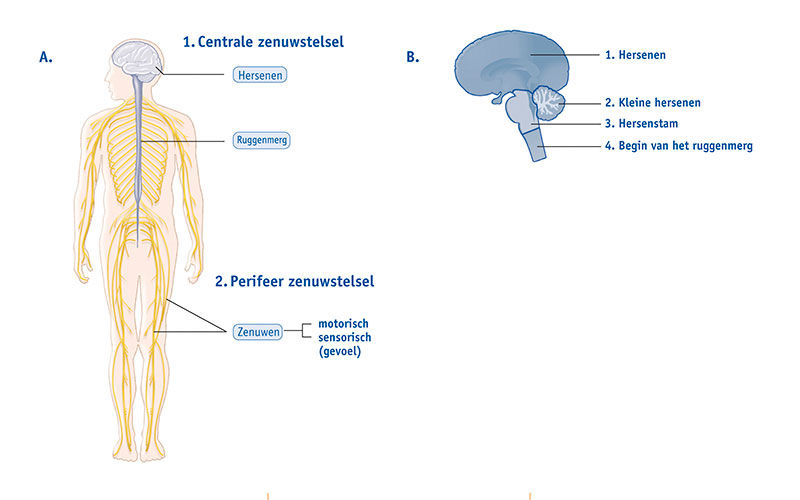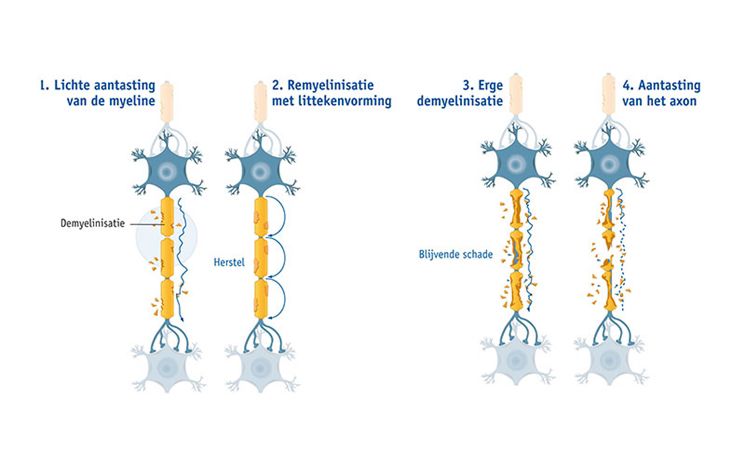What is MS?
What is Multiple Sclerosis?
MS and the Central Nervous System.
Multiple sclerosis is a disease that has to do with the central nervous system. Multiple Sclerosis is therefore not a muscle disease as many people think. To understand the effects of Multiple Sclerosis on the body, it is useful to first understand the function of the nervous system, how it works broadly and where the nervous system is located in the body. The central nervous system consists of the brain and spinal cord.

Operating system of the body
The nervous system is the operating system of the body. The central nervous system plays an important role in coordinating all kinds of conscious and unconscious activities that you undertake daily. Consider conscious activities such as moving, speaking, thinking and remembering. Also consider unconscious activities (reflexes), such as the withdrawal of your hand if you burn yourself. In addition, through this system we can observe all kinds of external stimuli and we are able to see, hear, smell, taste and feel.

What happens with Multiple Sclerosis?
Multiple Sclerosis has an effect on the central nervous system, causing Multiple Sclerosis complaints. Blood vessels run in the central nervous system, which supply the nervous tissue with oxygen and nutrients. With Multiple Sclerosis inflammation occurs in the brain, which is often located around the blood vessels and cause a slight swelling. These inflammations arise as a result of Multiple Sclerosis, because immune cells are activated to clear up the myelin. With Multiple Sclerosis, the immune cells cannot properly distinguish between the body's own substance and foreign substances in the body. The result is that the immune system is activated to clean up the body-own substance myelin. This damages the myelin, which provides a protective layer of insulation around the nerve shoots. This is the moment when the Multiple Sclerosis complaints arise. Multiple Sclerosis In the central nervous system all kinds of cells are involved.

An MS relapse
An inflammatory period in Multiple Sclerosis patients is often called a 'relapse', an 'exacerbation', a 'relapse' or a 'scale'. As a rule, the inflammation, which is the result of Multiple Sclerosis, calms down after a few weeks and recovery of the nerve tissue and myelin can occur. This transfers the information transfer. This recovery is unfortunately not always complete. Extensive inflammation caused by relapse often leaves a scar in the nervous tissue, which can cause residual symptoms of Multiple Sclerosis complaints. Due to the thinning myelin layer, information transfer via the nerve fibers can deteriorate and eventually nerve runners can be lost. The name Multiple Sclerosis for the disease stems from the clinical picture because there are often several (multiple) inflammatory sources with various scars (sclerosis) in the central nervous system. The extent to which this process occurs varies greatly from person to person.


Multiple Sclerosis symptoms
There are two phases (processes) that cause Multiple Sclerosis complaints:
⦁ - Multiple Sclerosis complaints due to the inflammation
⦁ - Multiple Sclerosis complaints due to myelin and axon damage
1. Multiple Sclerosis complaints due to the inflammation
Blood vessels run in the central nervous system, which supply the nerve tissue with oxygen and nutrients. The inflammation in Multiple Sclerosis is often located around these blood vessels and causes a slight swelling in the nervous tissue. This often makes information transfer (stimulus conduction) between the nerve cells in the brain more difficult. In addition, the myelin is damaged. That is the moment when someone gets Multiple Sclerosis complaints. Such an inflammatory period is often called a 'relapse', an 'exacerbation', a 'relapse' or a 'schub'. As a rule, the inflammation comes to rest after a few weeks.
2. Multiple Sclerosis complaints due to myelin and axon damage
The protective myelin layer is damaged during inflammation. As a rule recovery of the nerve tissue and myelin can occur and the information transfer between the different nerve cells is also restored. You can imagine that as more inflammations occur in the same spot, the damage to the myelin becomes more serious. This means that the myelin cannot fully recover; resulting in permanent damage or a scar in the nervous tissue.
Ultimately, the core of the nerve spurs, the axon, is damaged and the nerve spurs are lost. The name Multiple Sclerosis stems from the fact that there are often several (multiple) inflammatory sources with various scars (sclerosis) at different places in the central nervous system. The extent to which this process occurs varies greatly from person to person. The reduced information transfer in the central nervous system can cause various Multiple Sclerosis complaints. Varying in the sense of severity, as well as in the various types of Multiple Sclerosis complaints. The place in the central nervous system, where the inflammation occurs and where the myelin is broken down, determines the Multiple Sclerosis complaints that you have. Inflammation and damage to myelin can also occur without the occurrence of Multiple Sclerosis complaints.
The most common Multiple Sclerosis complaints at a glance:
Acute Multiple Sclerosis complaints
- Relapses
Chronic or periodic Multiple Sclerosis complaints
- Fatigue
- Feeling disorders
- Power reduction
- Stiffness / spasticity
- Problems with balance and coordination
- Pain
- Difficulty seeing
- Bladder and bowel problems
- Concentration and memory problems
- Heat intolerance
- Mood disorders
